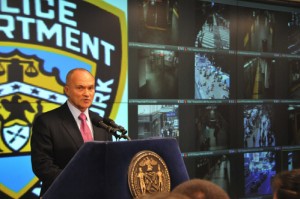By Pam Martens: April 3, 2013

Police Commissioner Raymond Kelly Inside the Surveillance Center in Lower Manhattan. The Center Is Staffed Jointly By NYPD and Wall Street Employees
The Partnership for Civil Justice Fund (PCJF) has released new documents it obtained under a Freedom of Information Act (FOIA) filing with the Department of Homeland Security (DHS). The documents show that DHS, the sprawling Federal agency ostensibly created to combat terrorism after the September 11 attacks, routinely spies on peaceful First Amendment activities and required daily briefing on the extent of media attention being given to Occupy Wall Street activities.
Media coverage both inside and outside of New York City was of concern to DHS. On October 7, 2011, a special agent sent a memo to inquire about Kansas City, asking: “Has there been any media attention given to the Occupy KC protests?”
A DHS employee expressed concern in an October 27, 2011 memo that Federal Protective Service personnel, a division of DHS, may have been caught on camera, writing: “Was there media coverage of the events last night which may show FPS involvement?”
As we previously reported, the Department of Homeland Security funded a high-tech, joint spy center in the heart of Wall Street where too-big-to-fail bank personnel work alongside NYPD officers to spy on the activities of Occupy Wall Street protesters as well as law abiding citizens on the streets. When the acclaimed CBS news program, 60 Minutes, became aware of the joint spy center, it presented a fawning program on its presence in lower Manhattan, neglecting to mention that Wall Street personnel were bizarrely spying on citizens alongside law enforcement personnel.
The new documents released by PCJF also show that DHS was interested in the Occupy movement’s ability to gain momentum through social media. In an October 2011 memo, an agent wrote:
“A distinct feature of OWS is how it was born from online organization and continues to use social media to spread its message, organize further protests, and keep protesters connected. OWS and the broader Occupy Together movement that organizes protests in other cities use services such as Twitter, Tumblr, Meetup, and Facebook to this end, as well as having set up a live video feed of the OWS encampment in New York. Announcements, videos, and images are all collected and disseminated via these social networks as well as on the OWS Web site.”
Another memo notes:
“Social media and the organic emergence of online communities have driven the rapid expansion of the OWS movement. In New York, OWS leaders have also formed ad hoc committees to organize protesters and manage communications, logistics, and security. The OWS encampment in Zucotti Park features a medical station, distribution point for food and water, and a media center complete with generators and wireless Internet. Organizers hold general assembly meetings twice a day and a have established committees and working groups including an Internet Working Group and a Direct Action Committee, which plans protest activities and works to maintain peaceful and controlled demonstrations. This high level of organization has allowed OWS to sustain its operations, disseminate its message, and garner increasing levels of support.”
Mara Verheyden-Hilliard, Executive Director of PCJF, commented as follows on the emerging pattern illustrated by the documents her organization is unearthing:
“This production of documents, like the FBI documents that the PCJF received in December 2012, is a window into the nationwide scope of DHS and FBI surveillance, monitoring, and reporting on peaceful protestors organizing with the Occupy movement. Taken together, the two sets of documents paint a disturbing picture of federal law enforcement agencies using their vast power in a systematic effort to surveil and disrupt peaceful demonstrations. The federal agencies’ actions were not because Occupy represented a ‘terrorist threat’ or a ‘criminal threat’ but rather because it posed a significant grassroots political challenge to the status quo.”

